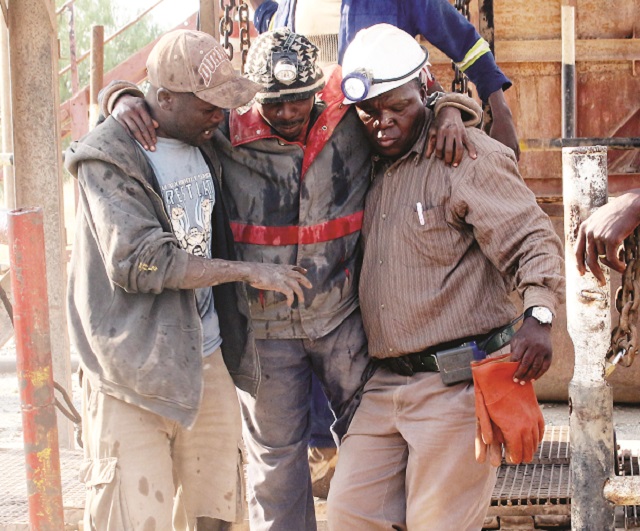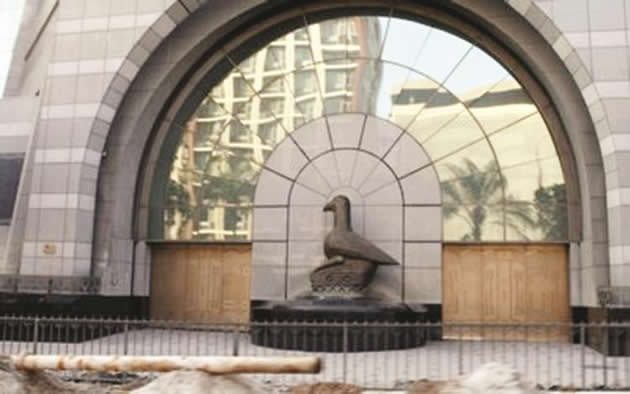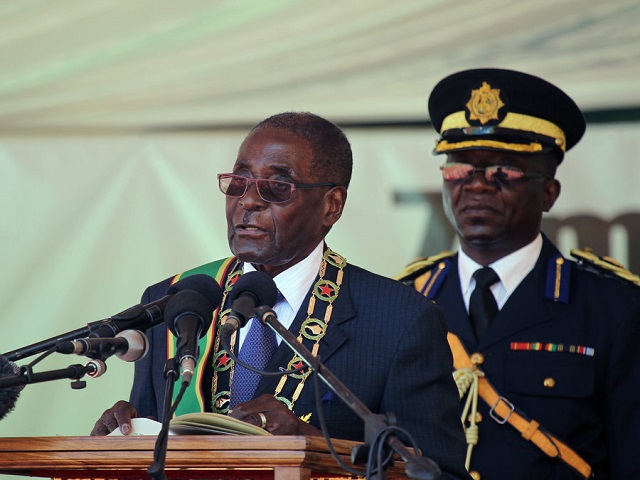EDITORIAL COMMENT: Break Durban Mine deadlock


Durban Mine acting manager Mr Onias Shanyurai assists an injured illegal miner and his colleague during the ongoing rescue attempt last week
The week-long standoff between mine management at Durban Mine in Bubi District and some 300 gold panners reads like a hostage movie.
Law enforcement agents see a potential disaster that can lead to mass deaths. They have an obligation to intervene to forestall that catastrophe but at the same time, they cannot simply move in to rescue the hostages lest they can endanger the lives of the captives. The difference between the Durban Mine case and normal hostage crises is that the hostage taker is actually the hostage who possesses dangerous weapons ready to hurt anyone trying to rescue him.
The drama started on Monday last week when a local businessman withdrew his ladder that had been used by the 500 panners to go down the mine to seek the yellow metal. Word had reached him that police were going to move in to arrest the artisanal miners. Fearing his own arrest, the unnamed businessman removed the ladder, leaving his 500 clients without a way out.
Matabeleland North police, who had rescued some 130 men by Friday, have been helpless in their efforts to save 300 panners who remain holed up 120m underground. Without food supplies and in their own world in the depths, the miners are fearful that if they stepped out, they would be immediately arrested. Police have sent rescued panners down to persuade their colleagues to surface with no risk of arrest, but they have stood their ground, threatening to kill the emissaries.
A team from the Zimbabwe Mining Federation (ZMF) was at the mine on Saturday to assess the unfolding drama and reported hearing explosions rocking the belly of the earth as the cadres worked.
ZMF spokesperson Mr Dosman Mangisi said on Monday:
“Although most of the miners had vacated the mine, we were told that some of the illegal panners were still underground. We could hear sounds of explosives being blasted from underground. The acting mine manager Mr Onias Shanyurai said the remaining panners were at the fourth level of the mine, which is more than 120 metres underground.
“Initially the management and the police couldn’t go underground to arrest them because some of them had dangerous weapons such as machetes and they were threatening to harm anybody disturbing them. They later started coming out in small groups and some of them left with gold ore.”
Although we don’t think they have a challenge with water supply as the liquid typically flows in abundance in underground mines, we are afraid that soon the panners will run out of food. If the standoff continues, they might begin wasting away and later possibly starving to death.
Before that happens the blasting that is taking place may compromise the integrity of the support structures and the mine can entomb the 300 to create one huge mass grave.
We are not prepared to lose lives at Durban Mine. We thus appeal to authorities to take every action possible to break that deadlock without any loss of life.
In saying this we are not underestimating the unique challenge that the people who must be rescued pose to those desperate to save them. As noted earlier, they have threatened to kill even their colleagues who surfaced and were being used as intermediaries.
In addition, we are not underestimating the spatial challenge that any rescue effort will face in the confines of the shaft and the tunnels underground. Rescuers will not be flexible enough to move around if the panners decide to fight. This would not be a problem if the standoff was on the surface.
Nonetheless, we suggest that more teams that the miners can trust be sent underground to continue persuading them to come out. We are hopeful that more of this can help.
One big, yet recurring lesson we learn from the Durban Mine standoff is the difficulty posed by the poisoned relationship that exists between panners and law enforcement agents. Panners don’t trust the police even when they genuinely want to save them like in the case in point.
Early this month, Reserve Bank of Zimbabwe Governor Dr John Mangudya said gold panning must be decriminalised.
“We said we should not arrest artisanal gold miners but I am informed that they are being arrested,” he said in Zvishavane. “I think we need to allow artisanal miners to mine their gold and take it to Fidelity Printers so that we generate more foreign currency and import fuel, raw materials and other necessities. Our laws are too many and archaic. We need to change that and adopt laws that will help us chart a new narrative for the economy. I am very serious about this matter because if we do not stop the arrest of artisanal miners, we do not harvest gold and remember there is nothing to harvest from the fields. We need to take hard, bold decisions to move the economy forward.”
His views are important in not only removing the traditional conflict between panners and the police but also in harnessing as much gold as possible to contribute to the turnaround of the economy. Of course the panning must be regulated for environmental issues.
In the bigger scheme of things, Dr Mangudya’s position makes sense. The Durban Mine situation may not be covered by his proposal because the 300 men trespassed into someone else’s claim and took, rather attempted to take his gold, two potential crimes. However, its delicate nature demands it be handled differently.











Comments